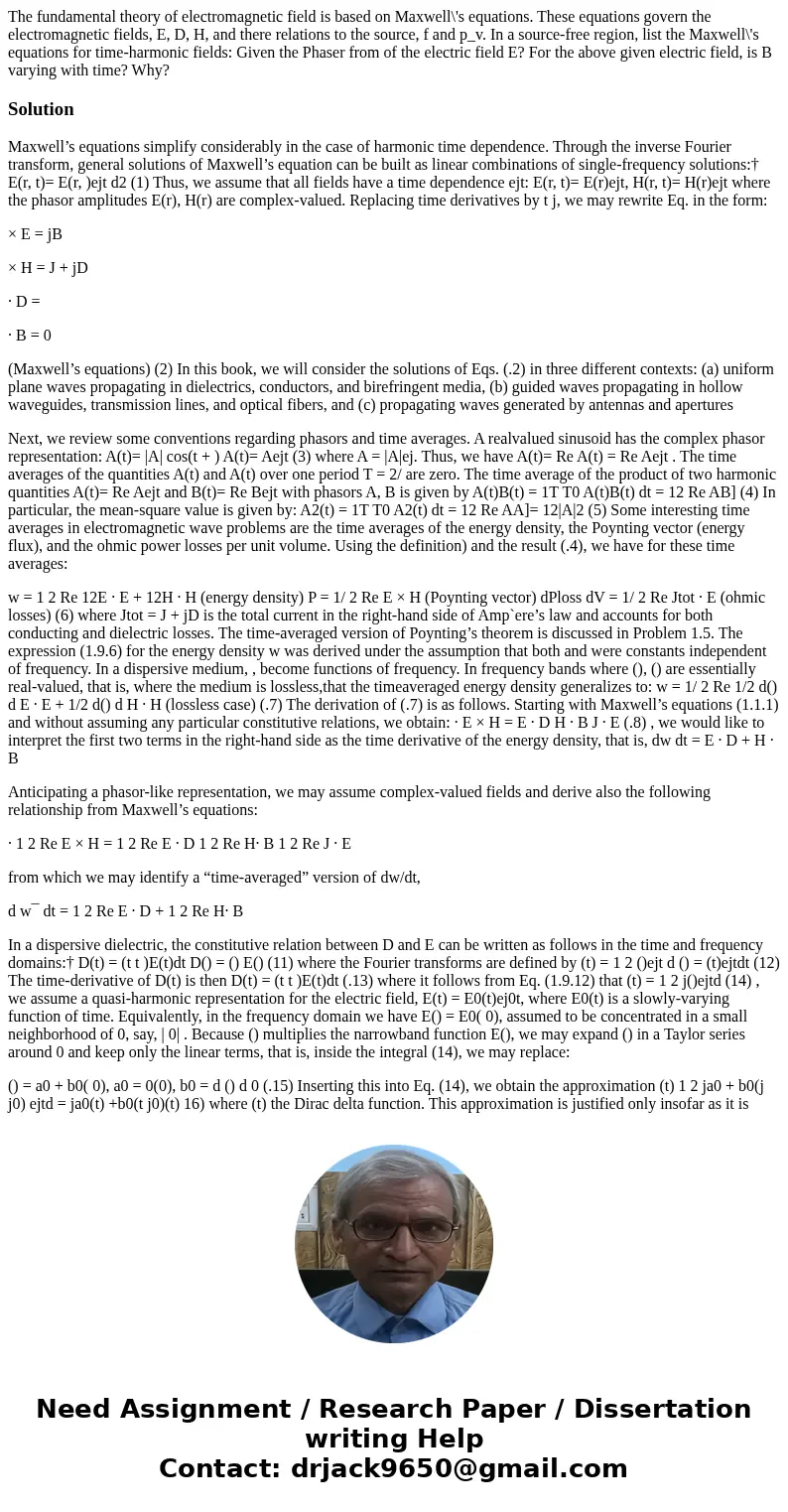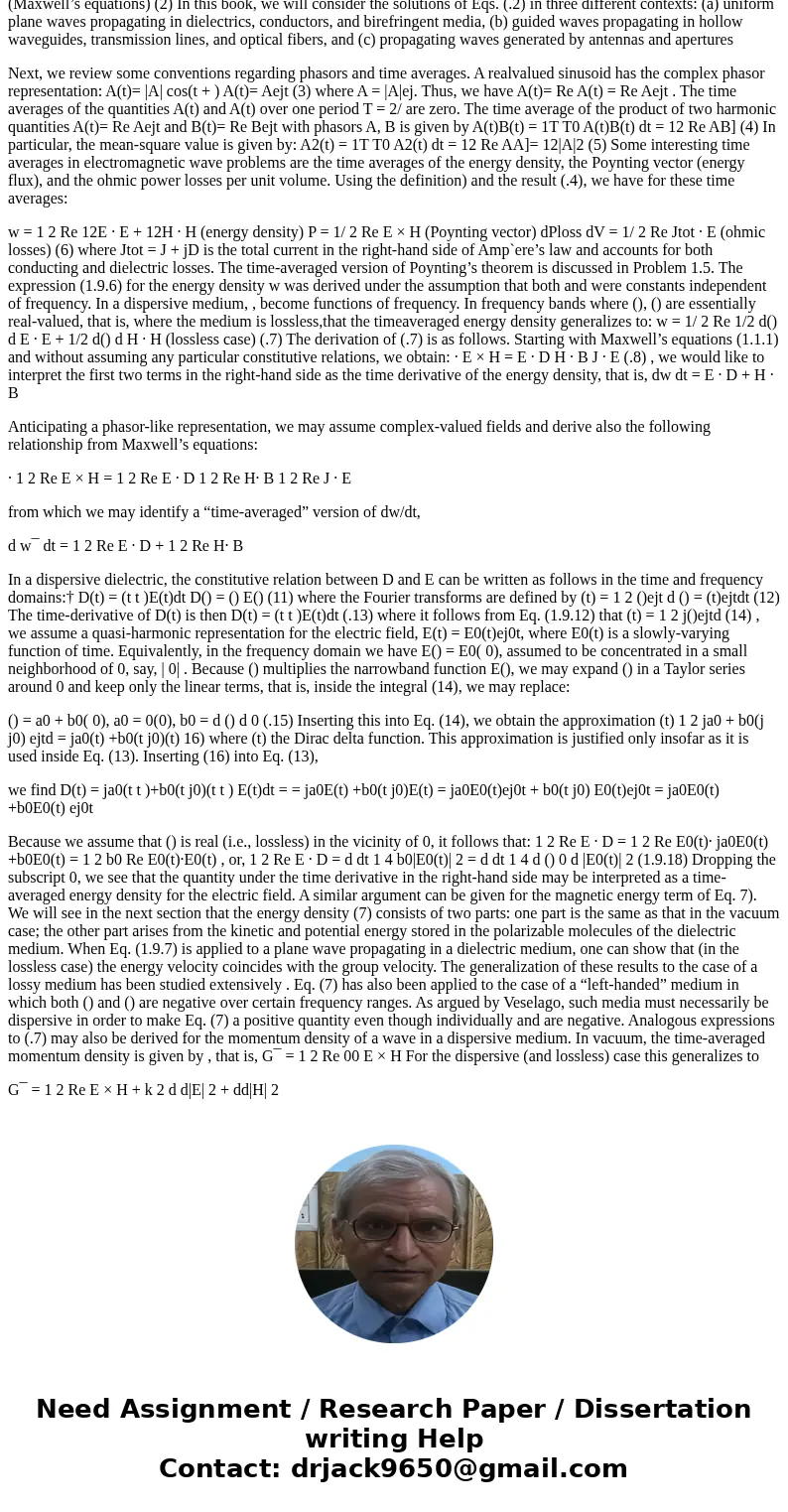The fundamental theory of electromagnetic field is based on
Solution
Maxwell’s equations simplify considerably in the case of harmonic time dependence. Through the inverse Fourier transform, general solutions of Maxwell’s equation can be built as linear combinations of single-frequency solutions:† E(r, t)= E(r, )ejt d2 (1) Thus, we assume that all fields have a time dependence ejt: E(r, t)= E(r)ejt, H(r, t)= H(r)ejt where the phasor amplitudes E(r), H(r) are complex-valued. Replacing time derivatives by t j, we may rewrite Eq. in the form:
× E = jB
× H = J + jD
· D =
· B = 0
(Maxwell’s equations) (2) In this book, we will consider the solutions of Eqs. (.2) in three different contexts: (a) uniform plane waves propagating in dielectrics, conductors, and birefringent media, (b) guided waves propagating in hollow waveguides, transmission lines, and optical fibers, and (c) propagating waves generated by antennas and apertures
Next, we review some conventions regarding phasors and time averages. A realvalued sinusoid has the complex phasor representation: A(t)= |A| cos(t + ) A(t)= Aejt (3) where A = |A|ej. Thus, we have A(t)= Re A(t) = Re Aejt . The time averages of the quantities A(t) and A(t) over one period T = 2/ are zero. The time average of the product of two harmonic quantities A(t)= Re Aejt and B(t)= Re Bejt with phasors A, B is given by A(t)B(t) = 1T T0 A(t)B(t) dt = 12 Re AB] (4) In particular, the mean-square value is given by: A2(t) = 1T T0 A2(t) dt = 12 Re AA]= 12|A|2 (5) Some interesting time averages in electromagnetic wave problems are the time averages of the energy density, the Poynting vector (energy flux), and the ohmic power losses per unit volume. Using the definition) and the result (.4), we have for these time averages:
w = 1 2 Re 12E · E + 12H · H (energy density) P = 1/ 2 Re E × H (Poynting vector) dPloss dV = 1/ 2 Re Jtot · E (ohmic losses) (6) where Jtot = J + jD is the total current in the right-hand side of Amp`ere’s law and accounts for both conducting and dielectric losses. The time-averaged version of Poynting’s theorem is discussed in Problem 1.5. The expression (1.9.6) for the energy density w was derived under the assumption that both and were constants independent of frequency. In a dispersive medium, , become functions of frequency. In frequency bands where (), () are essentially real-valued, that is, where the medium is lossless,that the timeaveraged energy density generalizes to: w = 1/ 2 Re 1/2 d() d E · E + 1/2 d() d H · H (lossless case) (.7) The derivation of (.7) is as follows. Starting with Maxwell’s equations (1.1.1) and without assuming any particular constitutive relations, we obtain: · E × H = E · D H · B J · E (.8) , we would like to interpret the first two terms in the right-hand side as the time derivative of the energy density, that is, dw dt = E · D + H · B
Anticipating a phasor-like representation, we may assume complex-valued fields and derive also the following relationship from Maxwell’s equations:
· 1 2 Re E × H = 1 2 Re E · D 1 2 Re H· B 1 2 Re J · E
from which we may identify a “time-averaged” version of dw/dt,
d w¯ dt = 1 2 Re E · D + 1 2 Re H· B
In a dispersive dielectric, the constitutive relation between D and E can be written as follows in the time and frequency domains:† D(t) = (t t )E(t)dt D() = () E() (11) where the Fourier transforms are defined by (t) = 1 2 ()ejt d () = (t)ejtdt (12) The time-derivative of D(t) is then D(t) = (t t )E(t)dt (.13) where it follows from Eq. (1.9.12) that (t) = 1 2 j()ejtd (14) , we assume a quasi-harmonic representation for the electric field, E(t) = E0(t)ej0t, where E0(t) is a slowly-varying function of time. Equivalently, in the frequency domain we have E() = E0( 0), assumed to be concentrated in a small neighborhood of 0, say, | 0| . Because () multiplies the narrowband function E(), we may expand () in a Taylor series around 0 and keep only the linear terms, that is, inside the integral (14), we may replace:
() = a0 + b0( 0), a0 = 0(0), b0 = d () d 0 (.15) Inserting this into Eq. (14), we obtain the approximation (t) 1 2 ja0 + b0(j j0) ejtd = ja0(t) +b0(t j0)(t) 16) where (t) the Dirac delta function. This approximation is justified only insofar as it is used inside Eq. (13). Inserting (16) into Eq. (13),
we find D(t) = ja0(t t )+b0(t j0)(t t ) E(t)dt = = ja0E(t) +b0(t j0)E(t) = ja0E0(t)ej0t + b0(t j0) E0(t)ej0t = ja0E0(t) +b0E0(t) ej0t
Because we assume that () is real (i.e., lossless) in the vicinity of 0, it follows that: 1 2 Re E · D = 1 2 Re E0(t)· ja0E0(t) +b0E0(t) = 1 2 b0 Re E0(t)·E0(t) , or, 1 2 Re E · D = d dt 1 4 b0|E0(t)| 2 = d dt 1 4 d () 0 d |E0(t)| 2 (1.9.18) Dropping the subscript 0, we see that the quantity under the time derivative in the right-hand side may be interpreted as a time-averaged energy density for the electric field. A similar argument can be given for the magnetic energy term of Eq. 7). We will see in the next section that the energy density (7) consists of two parts: one part is the same as that in the vacuum case; the other part arises from the kinetic and potential energy stored in the polarizable molecules of the dielectric medium. When Eq. (1.9.7) is applied to a plane wave propagating in a dielectric medium, one can show that (in the lossless case) the energy velocity coincides with the group velocity. The generalization of these results to the case of a lossy medium has been studied extensively . Eq. (7) has also been applied to the case of a “left-handed” medium in which both () and () are negative over certain frequency ranges. As argued by Veselago, such media must necessarily be dispersive in order to make Eq. (7) a positive quantity even though individually and are negative. Analogous expressions to (.7) may also be derived for the momentum density of a wave in a dispersive medium. In vacuum, the time-averaged momentum density is given by , that is, G¯ = 1 2 Re 00 E × H For the dispersive (and lossless) case this generalizes to
G¯ = 1 2 Re E × H + k 2 d d|E| 2 + dd|H| 2


 Homework Sourse
Homework Sourse